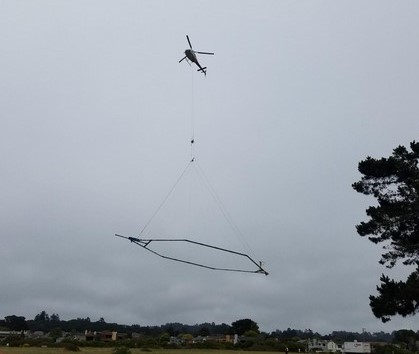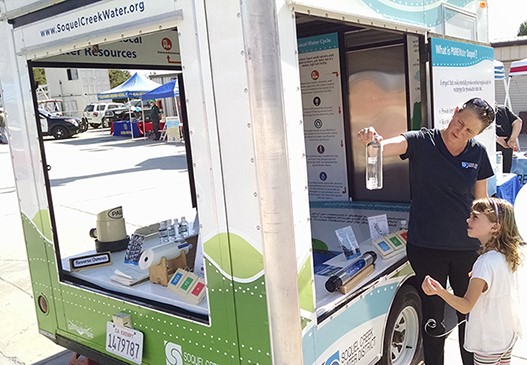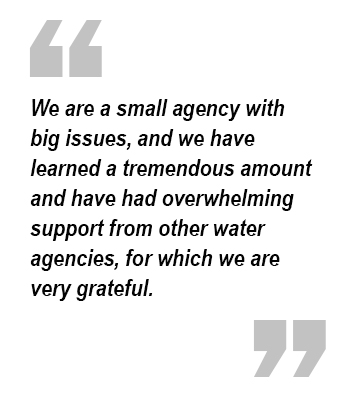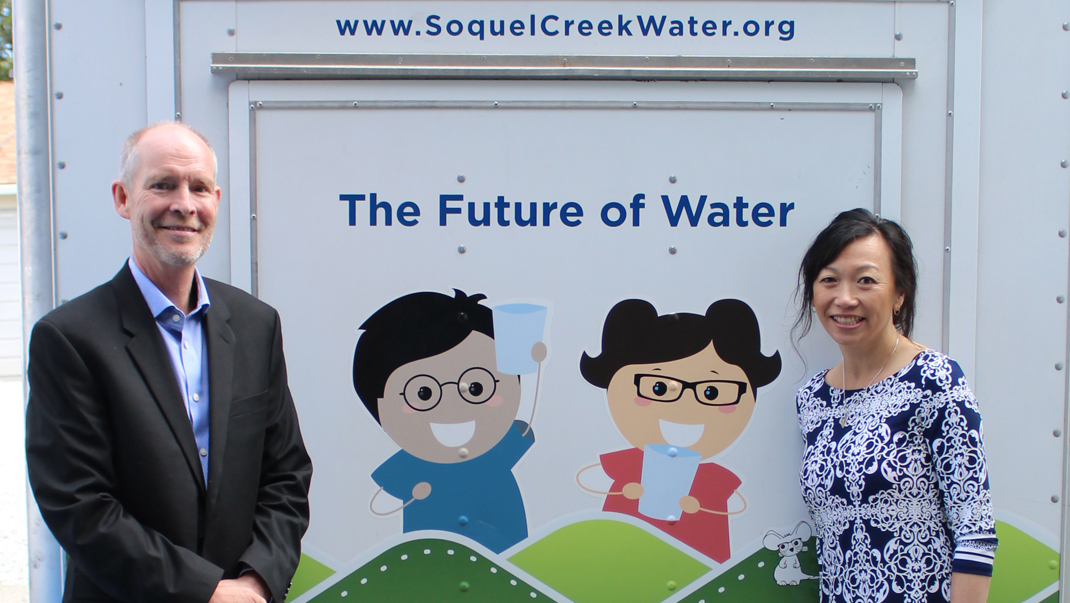The Soquel Creek Water District is a small agency facing big challenges, namely a groundwater basin that’s critically overdrafted with seawater intrusion. It is dedicated to serving its 45,000-strong community and protecting and replenishing the basin. But how? One word: Collaboration. Both here and abroad. Brown and Caldwell Senior Client Service Manager Anup Shah sat down with General Manager Ron Duncan and Special Projects-Communications Manager Melanie Mow Schumacher to see how the district is solving these water challenges and protecting its seven miles of California coastline.
Please give a high-level overview of the Soquel Creek Water District: How many people it serves, its geography, its source of supply, etc.
Soquel Creek Water District provides water and water resource management in the Mid-Santa Cruz County area. We’re located between San Francisco and Monterey and serve approximately 45,000 customers through 14,000 connections. Our customer base is primarily local residences, businesses and tourism. Our service area covers seven miles of coastline, reaching inland by three miles into the hills. Even though we’re called Soquel Creek, all the water we serve is from groundwater.
What are some of the immediate and long-term challenges facing the district in developing sustainable water supplies? How do you propose overcoming such challenges?
100% of our water supply is from groundwater and unfortunately this groundwater basin is critically overdrafted with seawater intrusion. We are one of 21 basins in California (the state has more than 500 basins) that has been designated by the state as critically overdrafted. Our primary focus right now is to protect and replenish the groundwater basin from seawater intrusion moving further inland and meeting the state mandate of basin sustainability by 2040.
 To address our seawater contamination issue, we continue to stay nimble and adapt, especially as new data and opportunities/issues come at us. Instead of trying to anticipate low-probability but high-impacts events, we aim to reduce our vulnerability to them. An example of this is how we recently collaborated with the Danish government and the Santa Cruz Mid-County Groundwater Agency to conduct an innovative study to locate the seawater/freshwater interface in our aquifers offshore. The study mapped seawater intrusion in the groundwater aquifers offshore of the Mid-Santa Cruz County area by collecting and recording geophysical measurements for scientific research purposes with a low-flying helicopter, using technology originally developed and used in Denmark. What the data confirmed was that the interface was right at the shoreline, we had hoped it was further offshore. The seawater intrusion is knocking on our door in terms of invading further into our aquifers where we hadn’t already detected it onshore.
To address our seawater contamination issue, we continue to stay nimble and adapt, especially as new data and opportunities/issues come at us. Instead of trying to anticipate low-probability but high-impacts events, we aim to reduce our vulnerability to them. An example of this is how we recently collaborated with the Danish government and the Santa Cruz Mid-County Groundwater Agency to conduct an innovative study to locate the seawater/freshwater interface in our aquifers offshore. The study mapped seawater intrusion in the groundwater aquifers offshore of the Mid-Santa Cruz County area by collecting and recording geophysical measurements for scientific research purposes with a low-flying helicopter, using technology originally developed and used in Denmark. What the data confirmed was that the interface was right at the shoreline, we had hoped it was further offshore. The seawater intrusion is knocking on our door in terms of invading further into our aquifers where we hadn’t already detected it onshore.
View the results of the 3D mapping of the seawater and freshwater interface just offshore of Capitola, Aptos and La Selva Beach, Calif.
This has changed the way we approach sustainability, moving from viewing it from an optimization lens to looking at it from a risk mitigation approach. Our approach considers the risk and consequence scenario, knowing that most populated coastal regions that rely on groundwater have already failed to prevent seawater intrusion from contaminating drinking water wells. 70% of coastal communities have seawater contamination; including to the south of us in Parajo Valley and in Monterey where seawater intrusion is up to 8 miles inland.
More information and a video of the low-flying helicopter in action around Mid-Santa Cruz County can be viewed here.
The Pure Water Soquel Project and Community Water Plan. Tell us more about the project, and it’s benefit to the community.
We are in year four of evaluating our Pure Water Soquel Project, a subset of the District’s Community Water Plan. The proposed project involves replenishing the critically over-drafted groundwater basin with 25% of the 8 million gallons per day of treated wastewater currently being sent to the Monterey Bay National Marine Sanctuary. Before replenishing the basin via recharge wells, the water would be purified through advanced water purification technologies such as microfiltration, reverse osmosis and UV/advanced oxidation. The project would also create a seawater barrier, so the freshwater/seawater interface doesn’t move further inland to contaminate our drinking water wells.
What’s unique about our project is that we are being very proactive in preventing something happening to our wells that will affect water quality. With the results of the helicopter study, we are in a situation to be proactive rather than reactive in terms of knowing where the seawater intrusion is taking place and stopping it before it gets further inland. We may be the first water agency to know that the seawater interface is right offshore and thus have the grand opportunity to stop it before it hits our community wells.
The Community Water Plan is the district’s overarching program that includes the development of new supplies, water conservation and adaptive groundwater management. Since the early 2000s, we have been looking at the development of new water supplies, and as we’ve done that, we’ve implemented an integrated, multi-faceted program of which water conservation is the cornerstone. In a community where people really embrace water conservation, we’ve funded and devised a lot of outreach and educational programs under the umbrella of the Community Water Plan.
The success of such programs has been evident in the fact that our customers on average presently use around 50 gallons per person per day, which is half of the statewide average. Since 2014, we’ve been in a Stage 3 water curtailment, so having a community that wants to conserve has been great, but conservation is a complement to the development of new water supplies, not a replacement.
Additionally, because our basin is critically over-drafted, we are participating in a Groundwater Sustainability Agency to meet the Sustainable Groundwater Management Act regulations.
The final aspect of the Community Water Plan is the development of new supplies. The Pure Water Soquel Project is one of four options that we are looking at. Other supply options to complement the project may involve excess river water, small stormwater capture projects, and following local desalination efforts.
What kind of organizational leadership tools might help to address the technical issues facing the district?
As we try to anticipate and mitigate challenges facing the district, we do a lot of exercises, one of which is a premortem as opposed to a postmortem. Most agencies try to learn from their mistakes, which is a great way to analyze a project and if it failed or succeeded, but in a premortem, you assume the project has gone off track. It’s beneficial because it gets people thinking outside of the box. It empowers people to speak up and share ideas and collaborate around potential scenarios and thus to take positive actions to shape our future and not just react.
When developing projects, keeping staff motivated with a high morale is really the key because it’s all about the people. The path to sustainable and supplemental supply projects is long and often convoluted, thus building and instilling organizational resilience to endure and prevail is critical. Bottom line, a strong organization includes alignment of the Board and staff and the community we serve.
I understand you have a very active community when it comes to water sustainability. Please share what educational/outreach programs you have implemented. What was the reaction from the community?
Something we’re very proud of is how we aim to involve the public and bring them up to speed about the state of our projects and what that means in terms of supply, resiliency and sustainability. Our Board recognizes the importance of public outreach and education which has been a tremendous help in us engaging with the community which has in-turn helped us understand the needs of our customers which we incorporate into our projects.
Much of our community understands and embraces the need to develop a new source of water. We’re very fortunate that they understand the problems we face. When we surveyed our customers on what was most important to them in a new supply, the top qualities were: high water quality, drought-proof/reliable, and timeliness. With seawater intrusion knocking at the door, our customers recognize the importance of action. These are the drivers that our Board has embraced in terms of the community sentiment.For the proposed Pure Water Soquel Project, a phone survey found that 59% of responders were in favor of purifying treated wastewater for groundwater replenishment. After further explaining the process for purifying the water and the advanced techniques used, the support grew to 77%.
 We have funded and undertaken many community outreach programs, ranging from a robust school education program to an educational mobile trailer that has been retrofitted with informational signs and purification artifacts that travels to events to inform and educate on water purification and water conservation. The district has recently created an on-site learning center that is open daily that tells the whole story about our water challenges and our proposed solutions.
We have funded and undertaken many community outreach programs, ranging from a robust school education program to an educational mobile trailer that has been retrofitted with informational signs and purification artifacts that travels to events to inform and educate on water purification and water conservation. The district has recently created an on-site learning center that is open daily that tells the whole story about our water challenges and our proposed solutions.
The district was recently awarded a state grant of up to $2 million. What do you plan to use this for?
We’re proud and appreciative of this. We were awarded the maximum amount of the planning grant, and we plan to complete our evaluation of the Pure Water Soquel Project with the grant. It will fund the environmental efforts, additional technical feasibility analysis and a pilot recharge well to look at storage and recharge capacities for purified water.
There is a lot of talk about the SMART utility and the utility of the future. What are your thoughts on what the utility of the future will look like?
There is no doubt that technology is evolving and playing an increasingly important role in the future of utilities. The availability and utilization of big data via digitization enables us to understand our customers’ needs better, therefore refining our processes and improving customer service and focus. As the trend for going digital increases, we must also remember that now, and in the future, the greatest tool that an organization can leverage is still its people, through continuous learning and enhancing engagement.
What does the future look like for Soquel Creek Water District? What can your community look forward to?
The future is bright! We’ve had this amazing opportunity to be innovative and collaborate with colleagues in Denmark and test technology offshore for the benefit of our customers and future generations. Our state and federal partners are supporting and investing in our efforts and believe in what we are trying to achieve. We are on the right track. We have a fantastic staff and our customers’ low water usage really is a statement of their willingness to work with us as we obtain a supplemental supply.
We have a mission (to help our community reach sustainability), but not an agenda. When our community comes to us with ideas, we listen. We believe in collaboration, openness, compromise, and empathy. Not everyone is going to be happy with every decision that is made as we conduct our business, but understanding the complexities of an issue and finding common ground can go a long way.
What can other utilities learn from Soquel Creek Water District?
 The great thing about public entities is that we are constantly learning from and sharing with our neighbors and counterparts. We are a small agency with big issues and we have learned a tremendous amount and have had overwhelming support from other water agencies, for which we are very grateful. Nobody is alone in California’s water challenges and collaborating, no matter what the challenge, is key.
The great thing about public entities is that we are constantly learning from and sharing with our neighbors and counterparts. We are a small agency with big issues and we have learned a tremendous amount and have had overwhelming support from other water agencies, for which we are very grateful. Nobody is alone in California’s water challenges and collaborating, no matter what the challenge, is key.
What we have learned that has worked for us at Soquel Creek Water District is:
- Customer service and education is paramount in the successful delivery of a project.
- Focus on your people and the rest will fall into place.
- Cultivate a team that can work together.
- Debate, listen and agree to move forward swiftly and appropriately.
- Be passionate about what you do.
What do you like to do when you aren’t solving water sustainability challenges for Mid-Santa Cruz County?
Ron: Spending time with my family and enjoying the beautiful California scenery is a passion of mine. I also wind-down by playing guitar with my friends. Yoga is my newfound friend.
Melanie: I like to goof around with sports (golf, bowl, roller skate, ping pong, spikeball) with my family-all of which I’m OK at but have lots of room for improvement! I’m known to have a lot of energy, so when I can I love to get outside and run. Currently, I’m training for a 50k race in October.
